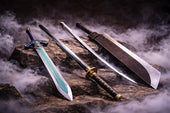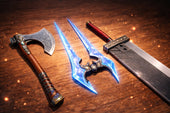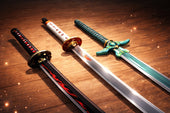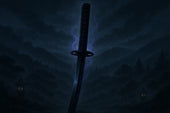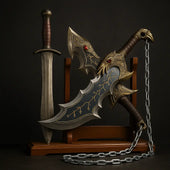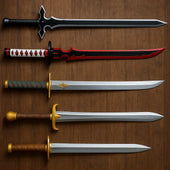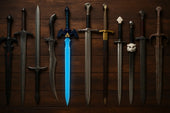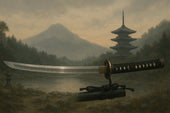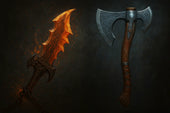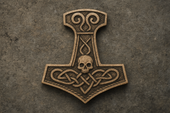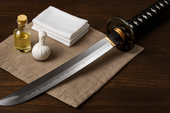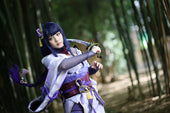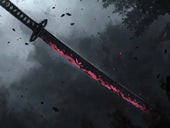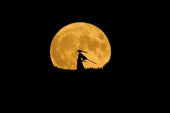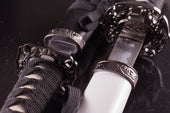Katanas have long been revered as more than just weapons; they are symbols of art, culture, and history! Originating in feudal Japan, these swords have transcended their martial origins to become iconic in global pop culture. Did you know that the katana's unique curvature allows for faster slicing motions, making it a preferred weapon among samurai? From samurai films to anime and video games, katanas represent honor, strength, and a connection to tradition. But how did these elegant blades achieve such legendary status? In this article, we'll delve into their historical roots, their portrayal in various media, and their enduring appeal in modern culture. Let’s unravel the story behind the katana!
1. The Historical Significance of the Katana
Origins and Evolution
The katana, often referred to as the "sword of the samurai," has a rich history that dates back to the Kamakura period (1185-1333). Initially developed as a response to the changing nature of warfare in Japan, the katana sword features a distinctive curved blade, which allows for quick drawing and slashing motions. Unlike its predecessors, which were often straight and heavy, the katana was designed for speed and precision. Its unique construction involves a complex forging process that combines multiple layers of steel, resulting in a blade that is both strong and flexible.
Role in Samurai Culture
The katana holds a special place in samurai culture, representing not just a weapon but a way of life. For samurai, the katana was an extension of their soul, embodying their values of honor, loyalty, and discipline. The practice of iaijutsu, or drawing the sword, emphasized the importance of skill and precision in combat. This deeply ingrained connection between the katana and the samurai way of life has contributed to its legendary status.
Symbolism and Craftsmanship
Craftsmanship is a crucial aspect of the katana's significance. Traditional Japanese swordsmiths, known as "togishi," dedicate their lives to perfecting the art of sword making. Each katana is a unique work of art, with intricate details that reflect the swordsmith's skill and dedication. The katana is often adorned with beautiful hilts, tsubas (handguards), and scabbards, making it not only a weapon but also a piece of cultural heritage.
2. Katanas in Film and Television
Iconic Movies Featuring Katanas
The katana's cinematic journey began in the early 20th century, but it truly exploded in popularity with films like "Seven Samurai" (1954) by Akira Kurosawa. This masterpiece showcased the katana in a realistic light, highlighting the skill and honor of the samurai.
Another landmark film, "Kill Bill" (2003), directed by Quentin Tarantino, brought the katana to the forefront of popular culture. The character O-Ren Ishii, portrayed by Lucy Liu, wields a stunning katana during a climactic battle, introducing a new generation to the weapon’s elegance and lethality.
The Portrayal of Samurai and Martial Arts in Cinema
Films have played a pivotal role in shaping perceptions of the katana. The portrayal of samurai as noble warriors battling for honor has contributed to the romanticization of the katana in the West. This depiction, often accompanied by choreographed sword fights and dramatic visuals, has solidified the katana's status as an iconic weapon in cinema.
Impact of Cinematic Techniques
The use of innovative cinematography and editing techniques has further enhanced the katana's appeal on screen. Slow-motion sequences, dynamic camera angles, and close-up shots of blade clashes create a visceral experience for the audience. These techniques allow viewers to appreciate the beauty and deadly precision of the katana, making it a captivating element of film.
3. Katanas in Anime and Manga
Popular Anime Series Featuring Katanas
Anime and manga have significantly contributed to the katana's iconic status. Series such as "Naruto," "Bleach," and "One Piece" feature characters wielding katanas, each with unique designs and abilities. For instance, Ichigo Kurosaki's Zangetsu in "Bleach" is a massive, oversized katana that reflects his character's strength and determination.
Cultural Significance in Japanese Animation
In Japanese culture, katanas symbolize not only martial prowess but also the struggles and journeys of the characters who wield them. They often represent the character's growth, embodying their quest for honor, revenge, or self-discovery. This deep cultural significance resonates with audiences, making katanas a powerful narrative device.
Global Influence of Anime
As anime gained popularity worldwide, so too did the fascination with katanas. Characters like Kenshin Himura from "Rurouni Kenshin" and Guts from "Berserk" have inspired fans to embrace the katana as a symbol of resilience and courage. This global influence has led to an increase in demand for katana replicas and merchandise, further embedding the weapon in pop culture.
4. Katanas in Video Games
Overview of Video Games Featuring Katanas
Video games have also played a crucial role in popularizing the katana. Titles like "Ghost of Tsushima" and "Sekiro: Shadows Die Twice" feature katana-wielding protagonists who embody the spirit of the samurai. In these games, players can experience the beauty and complexity of sword fighting, enhancing the katana's status as a symbol of skill and mastery.
Role in Gameplay Mechanics and Storytelling
The katana's design lends itself well to engaging gameplay mechanics. In "Ghost of Tsushima," players can utilize various combat styles, each emphasizing different aspects of swordsmanship. The katana becomes a tool for exploration, strategy, and storytelling, allowing players to connect with the culture and history behind the weapon.
Symbol of Skill and Mastery in Gaming Culture
In gaming culture, the katana represents not just a weapon but a badge of honor. Mastering the katana in games often requires dedication and skill, mirroring the training that real-life samurai underwent. This connection between the katana and the pursuit of excellence has solidified its status as an iconic weapon in the gaming community.
5. The Katana's Influence on Fashion and Merchandise
Rise of Katana-Inspired Fashion
The katana's influence extends beyond weapons and media; it has also made its mark on fashion. Designers have incorporated katana aesthetics into clothing and accessories, creating unique pieces that celebrate the elegance of the sword. From graphic tees featuring iconic katana imagery to fashion collections inspired by samurai culture, the katana has become a staple in contemporary fashion.
Collectibles and Replicas
The market for katana memorabilia has exploded in recent years. Fans and collectors can find a wide range of katana replicas, from high-quality functional swords to decorative pieces. These collectibles often feature intricate designs and craftsmanship, appealing to both martial arts enthusiasts and pop culture fans.
Influence on Modern Design and Art
The katana's elegance and symbolism have inspired various forms of modern art and design. Artists incorporate katana motifs into their work, exploring themes of honor, tradition, and identity. This fusion of traditional and contemporary influences showcases the katana's enduring appeal in modern culture.
Conclusion
In conclusion, the katana's journey from a historical weapon to a cultural icon is a testament to its enduring appeal! Through film, anime, video games, and even fashion, katanas have captivated audiences worldwide, embodying themes of honor, skill, and artistry. As they continue to inspire creators and fans alike, the legacy of the katana is far from over. So, whether you're a fan of martial arts, an anime enthusiast, or a gamer, embrace the beauty and significance of this legendary sword—its story is one worth celebrating!



